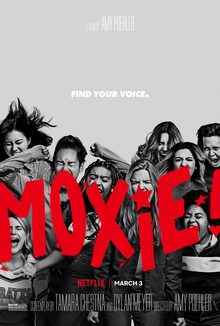Title: Moxie
Released: March 3, 2021
Produced by: Amy Poehler
Access on: Netflix
Netflix Summary: Inspired by her mom’s rebellious past and a confident new friend, a shy 16-year-old publishes an anonymous zine calling out sexism at her school.
Gaze Theory: This film focuses on fighting sexist thinking and the sexualization of women. However, in order to illustrate this, there are several examples within the film of sexualization and objectification of teenage girls. The examples presented are not necessarily examples of Gaze Theory. There are no instances of the female body being shown nude or covert sexualization. In fact, the sexualization that occurs is meant to be extremely overt. The largest example of this is the list that is created every year at school. Boys vote on the girls based on most bangable, best ass, hottest girl, best rack and so on. The list is then published for the entire school to see. This is the most prevalent and notable example of sexualization and objectification of teenage girls. In addition, there are many instances where the male characters are inappropriate or outright sexually harassing the female characters. Another example of this is when the principal of the school pursues Stephanie whose character is only 17-years-old.This type of behavior further enforces the idea that teenage girls are sexualized and objectified throughout their time in high school.
Sex Role Theory: Similarly, the film attempts to fight stereotypes associated with sex and gender roles. The film displays stereotypes and sexualization in order to show that it is a bad thing. In order to raise this point, the film utilizes many strong female characters. First, the main character, Vivian, becomes the leader of the group Moxie which is an all girls group devoted to fighting for women’s rights at the high school. She does so anonymously but in the end reveals her identity. She is an example of a female leader which contradicts the stereotype of women being subordinate and domestic workers. Her mother is also an example of this; she is a single mom who works in order to provide for her family. All the women throughout the film are depicted as activists and leaders. They fight against the sexualization and objectification of themselves and their peers. This offers a nice contradiction to what we often see in films. The all female cast can be inspiring to young teenage girls who may be experiencing the same type of sexual harassment in their schools.
Effects: I think this film does a wonderful job of fighting against the sexualization and objectification of teenage girls. Although it does depict sexualization and objectification, it does so in order to illustrate how disgusting this behavior is and that women must stand up for their rights. Teenage girls who may watch this film ,could be inspired by the leadership displayed, I know I was. The examples provided by the film, such as the list, are very relatable to many high school students. At my high school, the boys bathroom would have lists of the hottest girls written on the stalls; therefore, this list hit home for me. I think other teenage girls would have the same experience watching this film. Unlike other films, the behavior of these men and boys does not get swept under the rug. Instead, the girls speak up and the boys are held accountable for their actions. I think that this will help teenage girls everywhere stand up against sexual harassment instead of allowing themselves to be sexualized and objectified. In addition, if any teenage boys watch this film I believe that they may see how their behaviors can be harmful. Even something as small as writing a girl’s name on the bathroom stall can lead to these much larger societal problems that women face today.
Shared by: Olivia Smidel
Image Credit: https://en.wikipedia.org/wiki/Moxie_(film)
